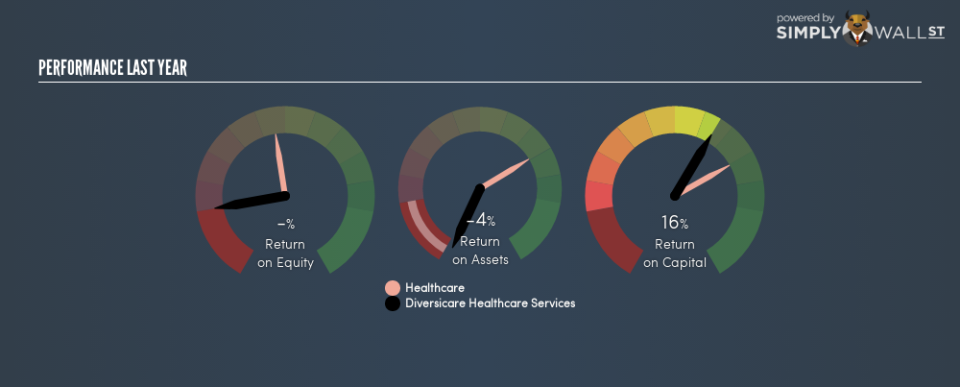Is Diversicare Healthcare Services, Inc.’s (NASDAQ:DVCR) 16% ROCE Any Good?

Today we are going to look at Diversicare Healthcare Services, Inc. (NASDAQ:DVCR) to see whether it might be an attractive investment prospect. Specifically, we’ll consider its Return On Capital Employed (ROCE), since that will give us an insight into how efficiently the business can generate profits from the capital it requires.
Firstly, we’ll go over how we calculate ROCE. Second, we’ll look at its ROCE compared to similar companies. Then we’ll determine how its current liabilities are affecting its ROCE.
Understanding Return On Capital Employed (ROCE)
ROCE measures the ‘return’ (pre-tax profit) a company generates from capital employed in its business. Generally speaking a higher ROCE is better. In brief, it is a useful tool, but it is not without drawbacks. Renowned investment researcher Michael Mauboussin has suggested that a high ROCE can indicate that ‘one dollar invested in the company generates value of more than one dollar’.
So, How Do We Calculate ROCE?
Analysts use this formula to calculate return on capital employed:
Return on Capital Employed = Earnings Before Interest and Tax (EBIT) ÷ (Total Assets – Current Liabilities)
Or for Diversicare Healthcare Services:
0.16 = US$17m ÷ (US$172m – US$69m) (Based on the trailing twelve months to September 2018.)
So, Diversicare Healthcare Services has an ROCE of 16%.
See our latest analysis for Diversicare Healthcare Services
Want to help shape the future of investing tools and platforms? Take the survey and be part of one of the most advanced studies of stock market investors to date.
Is Diversicare Healthcare Services’s ROCE Good?
When making comparisons between similar businesses, investors may find ROCE useful. Using our data, Diversicare Healthcare Services’s ROCE appears to be around the 13% average of the Healthcare industry. Regardless of where Diversicare Healthcare Services sits next to its industry, its ROCE in absolute terms appears satisfactory, and this company could be worth a closer look.
Remember that this metric is backwards looking – it shows what has happened in the past, and does not accurately predict the future. Companies in cyclical industries can be difficult to understand using ROCE, as returns typically look high during boom times, and low during busts. ROCE is only a point-in-time measure. If Diversicare Healthcare Services is cyclical, it could make sense to check out this free graph of past earnings, revenue and cash flow.
Diversicare Healthcare Services’s Current Liabilities And Their Impact On Its ROCE
Current liabilities are short term bills and invoices that need to be paid in 12 months or less. Due to the way ROCE is calculated, a high level of current liabilities makes a company look as though it has less capital employed, and thus can (sometimes unfairly) boost the ROCE. To counteract this, we check if a company has high current liabilities, relative to its total assets.
Diversicare Healthcare Services has total liabilities of US$69m and total assets of US$172m. As a result, its current liabilities are equal to approximately 40% of its total assets. With this level of current liabilities, Diversicare Healthcare Services’s ROCE is boosted somewhat.
What We Can Learn From Diversicare Healthcare Services’s ROCE
Diversicare Healthcare Services’s ROCE does look good, but the level of current liabilities also contribute to that. You might be able to find a better buy than Diversicare Healthcare Services. If you want a selection of possible winners, check out this free list of interesting companies that trade on a P/E below 20 (but have proven they can grow earnings).
I will like Diversicare Healthcare Services better if I see some big insider buys. While we wait, check out this free list of growing companies with considerable, recent, insider buying.
To help readers see past the short term volatility of the financial market, we aim to bring you a long-term focused research analysis purely driven by fundamental data. Note that our analysis does not factor in the latest price-sensitive company announcements.
The author is an independent contributor and at the time of publication had no position in the stocks mentioned. For errors that warrant correction please contact the editor at editorial-team@simplywallst.com.

